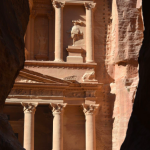Some may have seen this already, but I was saving it for this week:
Have we found the site of the Garden of Eden?
David Lewis-Williams, professor of archaeology at Witwatersrand University in Johannesburg, says: ‘Gobekli Tepe is the most important archaeological site in the world.’
…
The site of Gobekli Tepe is simple enough to describe. The oblong stones, unearthed by the shepherd, turned out to be the flat tops of awesome, T-shaped megaliths. Imagine carved and slender versions of the stones of Avebury or Stonehenge.
Most of these standing stones are inscribed with bizarre and delicate images – mainly of boars and ducks, of hunting and game. Sinuous serpents are another common motif. Some of the megaliths show crayfish or lions.
…
So far, so remarkable. If Gobekli Tepe was simply this, it would already be a dazzling site – a Turkish Stonehenge. But several unique factors lift Gobekli Tepe into the archaeological stratosphere – and the realms of the fantastical.
…
The first is its staggering age. Carbon-dating shows that the complex is at least 12,000 years old, maybe even 13,000 years old. That means it was built around 10,000BC. By comparison, Stonehenge was built in 3,000 BC and the pyramids of Giza in 2,500 BC. Gobekli is thus the oldest such site in the world, by a mind-numbing margin. It is so old that it predates settled human life. It is pre-pottery, pre-writing, pre-everything. Gobekli hails from a part of human history that is unimaginably distant, right back in our hunter-gatherer past.
…
Over glasses of black tea, served in tents right next to the megaliths, Klaus Schmidt told me that, as he put it: ‘Gobekli Tepe is not the Garden of Eden: it is a temple in Eden.’
National Geographic and nice pictures and more information:
Schmidt points to the great stone rings, one of them 65 feet across. “This is the first human-built holy place,” he says.
From this perch 1,000 feet above the valley, we can see to the horizon in nearly every direction. Schmidt, 53, asks me to imagine what the landscape would have looked like 11,000 years ago, before centuries of intensive farming and settlement turned it into the nearly featureless brown expanse it is today.
Prehistoric people would have gazed upon herds of gazelle and other wild animals; gently flowing rivers, which attracted migrating geese and ducks; fruit and nut trees; and rippling fields of wild barley and wild wheat varieties such as emmer and einkorn. “This area was like a paradise,”
Perhaps it was paradise? How interesting is that?
More (and more pics) here:
This region also has Biblical connections, tying it closer to the Eden narrative. Muslims believe that Sanliurfa, a nearby city, is the Old Testament city of Ur. Harran, a town down the road, is mentioned in Genesis twice.
Even the topography of Gobekli Tepe is ‘correct’. The Bible describes rivers descending from Paradise. Gobekli Tepe sits in the ‘fertile crescent’ between the rivers Tigris and Euphrates. The Bible also mentions mountains surrounding Eden. From the brow of Gobekli’s hills you can see the Taurus range.
Archeology.org has covered it.
And how do you like what appears to be the world’s oldest statue. Yeah, I think it’s a little haunting, too.
I’m still not talking about news, although this story makes me think that perhaps President Obama has a loose screw. We’re freezing, the solar flares are not happening, and he wants to chill the air and engineer the climate? Ho-kay.
In the Beginning there was…climate: The question gets asked, “was it ‘climate change’ that created a mysterious civilization 5,000 years ago?”
I’ve said it before and will say it again. It takes colossal conceit to believe that we puny humans, who are powerless in 100 mph winds, can seriously control nature, or creation or chaos. But we sure can add to chaos.
Meanwhile, it’s interesting, all of the things archeologists are finding lately:
The Pool of Siloam
King David’s Palace
Ancient saintly relics
Babel











